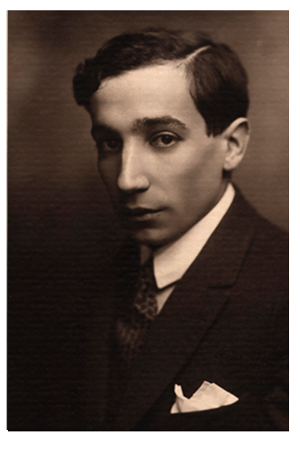|
JOSÉ PACHECO 1885-1934 |
 |
|
1885 |
24th of April José Rosa dos Santos Pacheco is born in Lisbon, son of a merchant, Francisco da Rosa Pacheco, and of Maria Carlota dos Santos Pacheco. |
|
1902-? |
Studies Architecture at the Academia de Belas-Artes de Lisboa, a course he completes with honours. |
|
1907 |
Project for a Café-Concerto (reproduced in the magazine A Construção Moderna of the 10th of September 1907 and, almost twenty years later in Ilustração Portuguesa, 25th of September 1926.) |
|
1910 |
Collaborates with Francisco Franco on a project for a monument to the Peninsular War, in Porto. Leaves for Paris and studies Architecture at the École des Beaux-Arts where he will also teach. Lives with Amadeo de Souza-Cardoso in Montparnasse. |
|
1912 |
Jorge Barradas produces a portrait of Pacheco |
|
1913 |
Designs the cover of Dispersão, by Mário de Sá-Carneiro. Travels to Lisbon and, in December, marries the painter Maria Etelvina Lobo dos Santos e Silva. |
|
1914 |
Returns definitely to Lisbon at the outbreak of World War I. |
|
1915 |
A specimen issue of Contemporânea is launched, of which he is the Editor. Designs the cover of Céu em Fogo: oito novelas, by Mário de Sá-Carneiro. Designs the cover of Orpheu 1. Collaborates in the ultranationalist magazine A Ideia Nacional, which publishes 18 issues between March and May of 1915, and has a second series in 1916, which has been lost. In this year, he was even its Artistic Director. |
|
1916 |
Founds the Galeria das Artes, in the Rua Serpa Pinto (previously the site of Salão Bobone). Tries to return to Paris, but is unable to,due to lack of money. |
|
1917 |
Signs, with Ruy Coelho, the Manifesto dos Ballets Russes written by Almada Negreiros, which will feature as a leaflet in the magazine Portugal Futurista. Publishes an architectural project for a church in the Portuguese-Brazilian magazine Atlântida: "A egreja de Sto. António do Monte (Murtosa), n.º 18, 1917, pp. 454-455. |
|
1918 |
April : Designs the set for the ballet A Princesa dos Sapatos de Ferro (The Princess with Iron Shoes)with music by Ruy Coelho and choreography and costumes by Almada, a Portuguese interpretation/reading/version of the Ballets Russes who had just held four performances in Lisbon (on the 13th and 17th of December 1917 at the Coliseu and on the 2nd and 3rd of January at the S. Carlos Theatre. 13 e 17 de dezembro de 1917 no Coliseu e a 2 e 3 de janeiro de 1918 no S. Carlos). |
|
1919 |
Tries, unsuccessfully, to found the Sociedade Portuguesa de Arte Moderna (Portuguese Society of Modern Art). Publishes a new architectural project for a house in the Portuguese-Brazilian magazine Atlântida: "Habitação Particular para o Parque Estoril", n.º 35-36, 1919, pp. 1092-93. |
|
1920 |
Participates in the 3rd Exhibition of the Grupo de Humoristas Portugueses (June 1920), in the area of Industrial Arts, with a living room table designed by him (on sale for 70 escudos). |
|
1921 |
Almada draws his portrait (Calouste Gulbenkian Foundation Collection - FCG Collection). |
|
1922 |
Is involved in a controversy, which he will divulge in Contemporânea, while organising a movement for the modernisation of the SNBA (National Society of Fine Arts). |
|
1923 |
The magazine De Teatro publishes a portrait of Pacheco, done the previous year by Vázquez Díaz (a collaborator of Contemporânea) when he visited Portugal. |
|
1925 |
João de Castro interviews him for Diário de Lisboa, on the 29th of January, highlighting his role as a “grande animador" (great enthusiast) and as responsible for the "melhores manifestações do modernismo em Portugal"(best manifestations of modernism in Portugal). Mário Eloy paints his best-known portrait which he shows that year at the I Salão de Outono, organised by Eduardo Viana (FCG Collection). Collaborates in the I Salão de Outono with: “Café-Restaurante de Lisboa (Palace Hotel – Rua Eugénio dos Santos)”; “Projecto de um Teatro” and “Projecto de uma casa alentejana”. Collaborates in the first issue of Europa (dir. Judith Teixeira), with “Projecto de um Teatro moderno”. |
|
1925-26 |
Produces paintings for the new panels of the café A Brasileira, as well as for the Bristol Club. |
|
1926 |
Is responsible for the II Salão de Outono. Final series (with three issues) of Contemporânea. |
|
1929 |
Directs the first four issues of the magazine Revista da Solução Editora. His health worsens and he has to leave this position. From no. 5 and until the end (no. 18), the magazine is directed by an archeologist, Rogério Rego, and becomes much more historically oriented and hardly literary at all. Pacheco leaves this magazine for the brief reappearance of Contemporânea, as said at the beginning of no. 5. |
|
1930 |
Participates in the I Salão dos Independentes, the manifest of which is written by the artist and writer António Pedro (1909-1966). |
|
1931 |
Death of his wife. |
|
1932 |
After some time at a health clinic, he decides to leave and try to heal himself at home, with his mother. |
|
1934 |
28th of September: dies of tuberculosis. On the 2nd of October, the SNBA (National Society of Fine Arts) sends a letter of condolences to his family (mother and sister). |
